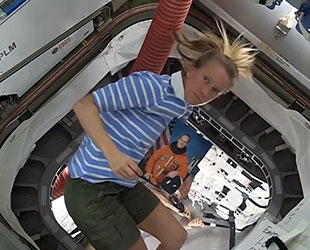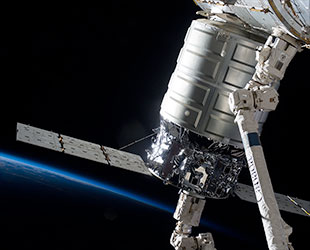October 22, 2013 — Just before the hatch was closed to Orbital Sciences' first Cygnus resupply spacecraft, NASA astronaut and Expedition 37 flight engineer Karen Nyberg came floating out of the barrel shaped ship holding a photo of another space explorer — the namesake for the vehicle she was now exiting for the last time.
Hovering for a moment inside the Harmony module on the International Space Station, Nyberg affixed the portrait of the late space shuttle astronaut G.David Low to the hatch, which when shut would separate the "Spaceship G. David Low" from the orbiting complex.
The first-of-its-kind private cargo ship had been berthed at the station since late September, but was now emptied of its supplies and repacked with trash to be discarded when the ship is destroyed re-entering the Earth's atmosphere.
On Tuesday (Oct. 22), Nyberg and her fellow crewmate, Luca Parmitano with the European Space Agency (ESA), were at the space station's robotic arm controls to release the Cygnus from its perch, beginning its the journey back to Earth.

NASA astronaut Karen Nyberg floats out of Orbital's first Cygnus cargo craft with a photo of the late G. David Low — the namesake for the spaceship — on Monday, Oct. 21, 2013. (NASA TV) |
The Spaceship G. David Low – named in memory of Low, who made three spaceflights and helped lead the Virginia-based Orbital's development of a commercial cargo launch service prior to his death in 2008 — was released from the space station at 6:31 a.m. CDT (1131 GMT).
On Wednesday, the Cygnus, orbiting free from the station and under the control of Orbital's flight engineers, will fire its engines for a last time at 12:41 p.m. CDT (1741 GMT), setting up its fiery re-entry over the Pacific Ocean.
Launched Sept. 18 atop the company's Antares two-stage rocket, Orbital's first Cygnus spacecraft lifted off from the Mid-Atlantic Regional Spaceport at NASA's Wallops Flight Facility in Virginia. It arrived at the station 11 days later, a week late after a GPS data glitch and arriving Soyuz crew delayed its rendezvous.
Cygnus delivered about 1,300 pounds (589 kilograms) of cargo, including food, clothing and student experiments to the Expedition 37 crew aboard the orbiting laboratory. The freighter was only partially packed for this demo mission; future flights of Cygnus will fly larger payloads, increasing NASA's ability to deliver equipment and spare parts to the space station.

Attached to the Harmony node, the first Cygnus cargo spacecraft built by Orbital Sciences Corp., in the grasp of the Canadarm2, is photographed on the International Space Station. (NASA) |
Orbital is the second of two commercial companies to fly demo flights to the space station as a part of the agency's Commercial Orbital Transportation Services (COTS) effort. The goal of COTS was to develop safe, reliable and cost effective cargo transportation systems. With this Cygnus mission coming to its successful end, the COTS program will be complete.
Orbital is now poised to begin this December with a series of eight Cygnus cargo missions to the space station under a $1.9 billion Commercial Resupply Services contract with NASA through 2016.
